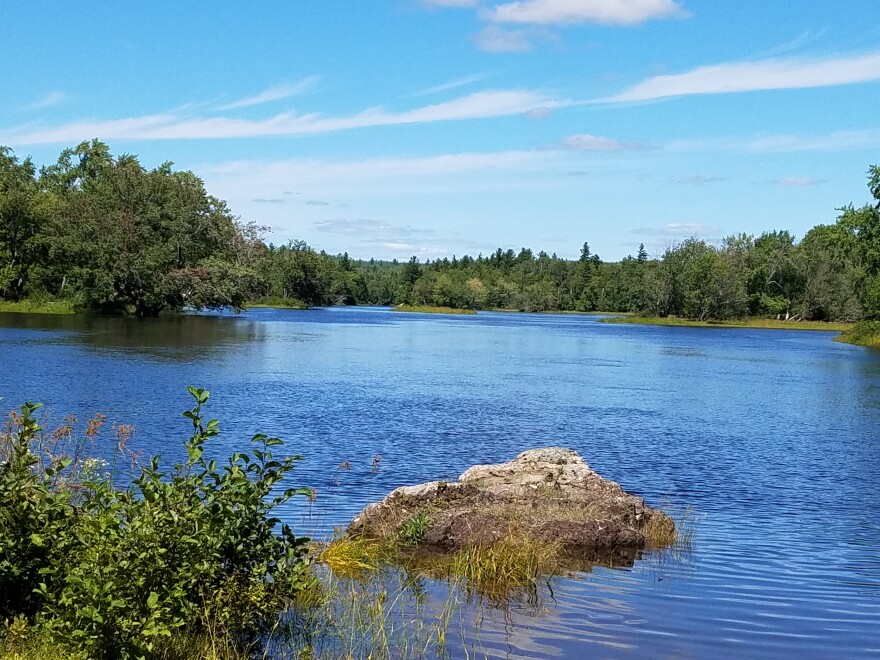Interior Secretary Sally Jewell capped off a week-long celebration of the National Park Service with a visit to the nation’s newest national monument: Katahdin Woods and Waters in the heart of Maine’s North Woods. Jewell paddled several miles of the East Branch of the Penobscot River, took a hike in the woods and shared her thoughts about moving past the rhetoric that has clung to the historic project for years.
To see a detailed map of the new monument, click here.
Jewell began her day with a tour of the Lumberman’s Museum in Patten where Maine’s colorful logging history is on display in hundreds of photographs and artifacts and a life-size logging camp. On the table in the cook house is a “no talking” sign, and for good reason, explains curator Rhonda Brophy.
“Because the cook wanted ‘em in and out ‘cause he did four meals a day,” says Brophy. “And he didn’t want to hear ‘em complaining. And sometimes they would get into fights and things like that.”
From the museum, Jewell headed for the East Branch of the Penobscot River at Matagamon, just north of the monument’s border. After a quick safety talk from one of several guides on the trip, Jewell hopped in a canoe and paddled eight miles of the river to a quiet picnic stop.

Along this route the river bends and widens giving paddlers occasional landscape-sized views of forest-covered mountains. Here, it’s not unusual to see moose and deer or to hear the smacking tail of a beaver. This is the ancestral homeland of the Penobscot Indian Nation and a place that once enchanted the likes of Henry David Thoreau and Teddy Roosevelt. Roosevelt famously lost a hiking boot somewhere in these waters and went on to climb Mount Katahdin in a pair of moccasins.
The East Branch includes slow moving and swift currents, including a stretch of rapids where Jewell showed off her paddling skills.

“I can’t think of a better place to be on a more beautiful day in a more beautiful place,” says Jewell. “I mean this is really incredible. And what a gift to the American people for generations to come Roxanne Quimby and her family have given all of us.”
Jewell shared a canoe with Lucas St. Clair, the son of land donor Roxanne Quimby, who’s dreamed of turning over this property to the National Park Service for nearly 20 years. For the past five of those years, St. Clair has been the leading pitchman for the project – at one point living out of his van and sleeping in parking lots so he could meet with anyone he could to discuss the idea, especially the opposition.
“I would look on websites and Facebook and see who was talking about this and literally drive to people's houses and knock on their door,” St. Clair says. “And I think there’s a vulnerability of exposure to say, ‘Here I am, if you really feel a certain way let’s talk.' And that evolved to where we are now.”

St. Clair has made converts of many of those opponents, some of whom think the monument will somehow detract from the forest products industry, an industry that has seen paper mills close, that's shed jobs and which now finds itself in transition.
But Jewell says people forget that it was a timber company that sold this land to Roxanne Quimby in the first place. It could have been developed into house lots or closed off to the public completely. Instead, 87,500 acres are being conserved for wildlife, recreation, and to tell the story of Maine’s North Woods.
“You have to give people a picture of the future that they see themselves in,” says Jewell. “And so if the picture people have seen themselves in involves logging or involves the aftermath when logging has gone away, how do we paint a picture that shows a brighter future? It’s hard to let go of the ‘from’ if you don’t know what the ‘to’ is.”

Jewell says the next step is to invite residents of local communities help shape the future of the monument the way they’d like to see it operate. The Park Service has scheduled a series of public meetings in the region the week of Sept. 12.
Tim Hudson is the project lead for the Park Service. Of the meetings, Hudson says, “We certainly want to see their vision and where they want to go. This is not something to see our vision. This is not our vision. These are truly listening sessions.”
Hudson says that issues like how many visitors should be allowed, what kind of rules and regulations should be included and how the monument should be developed will all be on the table.
Currently, there are a few campsites and latrines, a boat launch and some picnic areas and hiking trails accessible by a tote road. But more facilities are planned. Either way, Secretary Jewell says the feeling one gets here is reason enough to visit.
“You can’t describe what it’s like to be out in a nature in a beautiful place like this,” Jewell says. “You have to see it for yourself.”
And visitors are coming. Last Wednesday, when the designation of the national monument was announced, the Park Service had 200 maps printed. By Friday they had handed them all out.



